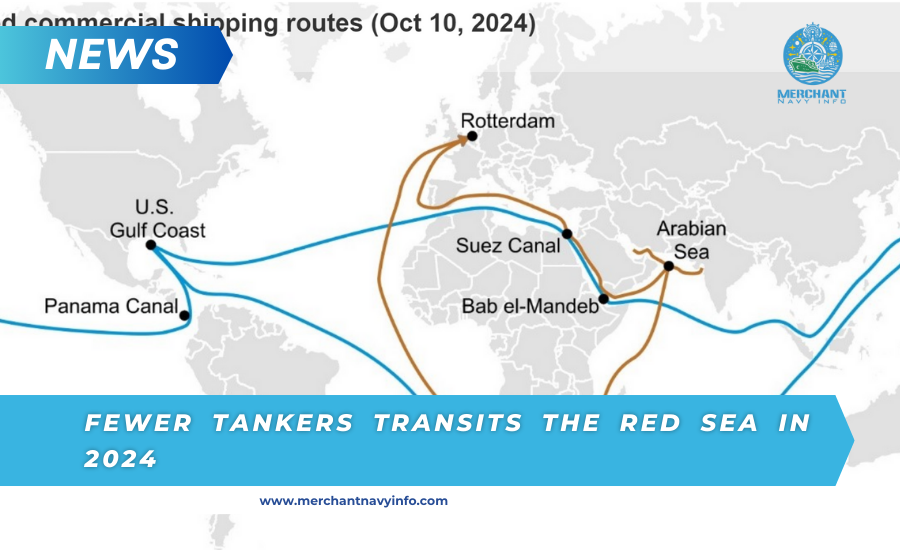
The number of tankers crossing the Red Sea will decrease in 2024
The crude oil and its derivatives flowing through the chokepoint of Mandeb, the southern entrance to the Red Sea, fell by more than 50% in the first eight months of 2024.
The checkpoint is a narrow passage on a widely used global shipping route critical to global energy security. Oil’s inability to pass through a major chokepoint, even temporarily, can lead to severe supply delays and higher transportation costs, which in turn leads to higher global energy prices.
After Yemen’s Houthi militias began attacking commercial ships crossing the Red Sea in November 2023, some ships began choosing to avoid the chokepoint of the Bab el-Mandeb Strait, a narrow strait bordering the Yemeni coast and the southern entrance to the Red Sea. Sea. Red Sea. Instead, they chose to take the longer and more expensive route around the Cape of Good Hope at the southern tip of Africa.
Commercial oil flows in the Red Sea have fallen sharply over the past year. Vortexa data shows that commercial oil flows through the Bab el-Mandeb Strait averaged 4 million barrels per day in 2024-8, compared with 8.7 million barrels per day in 2023.
The Suez Canal, SUMED Pipeline, and Bab el-Mandeb Strait are strategic routes for transporting oil and gas from the Persian Gulf to Europe and North America. The Suez Canal and SUMED Pipeline are located in Egypt and connect the Red and Mediterranean Seas. Vortexa data shows that the volume of crude oil and petroleum products flowing around the Cape of Good Hope increased to 9.2 million barrels per day in the first eight months of 2024 from an average of 6 million barrels per day in 2023.
The Strait of Hormuz is located between Oman and Iran, connecting the Persian Gulf, the Gulf of Oman, and the Arabian Sea. It is the world’s most important oil strait, and much oil flows through it. By 2023, the average oil flow through Hormuz will reach 20.9 million barrels daily, accounting for about 20% of the world’s liquid petroleum consumption. In addition, by 2023, about one-fifth of global liquefied natural gas trade will also pass through the Strait of Hormuz.
Selected Commercial Shipping Modes (as of June 2024)
Despite international sanctions limiting its production, Iran will become the world’s third-largest oil reserve owner and the second-largest natural gas reserve owner by 2023. Iran’s total petroleum and other liquids production has risen from a recent annual low of less than 3 million barrels per day in 2020 to an average of 4 million barrels per day in 2023. Of these 4 million barrels daily, approximately 29.1 million are crude oil, and the rest are hydrocarbon condensate and liquefied gas.
Saudi Arabia is the world’s third-largest crude oil and condensate producer, the world’s largest crude oil exporter, and OPEC’s largest crude oil producer in 2023, with an average daily production of 9.5 million barrels by then.
Israel is the second-largest natural gas producer in the Eastern Mediterranean, second only to Egypt. Natural gas production in Israel grew in 2013 after the Tamar field came onstream. Since then, multiple offshore gas fields have begun production and have provided enough fuel to meet Israel’s growing domestic natural gas needs and exports to Egypt and Jordan. In 2022, Israel’s natural gas production reached 808 billion cubic feet.
International Oil Prices and the U.S. Market
Crude oil imports from the Persian Gulf countries to the United States have declined over the past decade due to increased domestic production. In 2023, U.S. crude oil imports from the Persian Gulf countries averaged 609,000 barrels per day, up from 2 million barrels per day in 2013. The region’s exports accounted for 9.3% of total U.S. crude oil imports in 2023.
Crude oil is traded globally, and regional influences on international energy trade can impact global prices. Escalating tensions in the Middle East heightens geopolitical risks to global oil prices.









